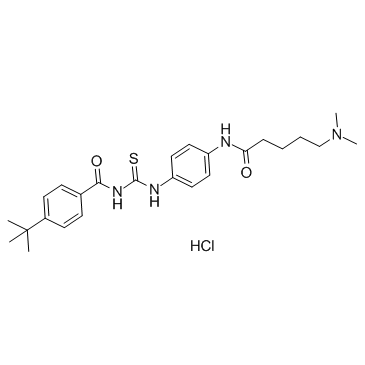1011301-29-3
| Name | Tenovin 6 Hydrochloride |
|---|---|
| Synonyms |
MFCD28099814
N-[(4-{[5-(Dimethylamino)pentanoyl]amino}phenyl)carbamothioyl]-4-(2-methyl-2-propanyl)benzamide hydrochloride (1:1) Benzamide, N-[[[4-[[5-(dimethylamino)-1-oxopentyl]amino]phenyl]amino]thioxomethyl]-4-(1,1-dimethylethyl)-, hydrochloride (1:1) Tenovin 6 (Hydrochloride) |
| Description | Tenovin-6 Hydrochloride is a water soluble inhibitor of SIRT1 and SIRT2, slightly inhibits HDAC8, and is also a potent activator of p53, with IC50s of 21 μM, 10 μM, 67 μM for SirT1, SirT2, and SirT3, respectively. |
|---|---|
| Related Catalog | |
| Target |
SIRT2:10 μM (IC50) SIRT1:21 μM (IC50) SIRT3:67 μM (IC50) HDAC8 MDM-2/p53 |
| In Vitro | Tenovin-6 inhibits the growth of S. cerevisiae cultures with an IC50 of 30 μM and is more toxic to yeast than the less water-soluble tenovin-1. Tenovin-6 rapidly increases the levels of endogenous K382-Ac p53 in MCF-7 cells[1]. Tenovin-6 (0 to 15 μM) dose dependently increases the level of LC3-II in diverse cell types, and the increase is ATG5/7 dependent. Tenovin-6 treatment also increases the number and intensity of autophagic vesicles with or without the presence of Torin 1, and prevents Torin 1-induced SQSTM1/p62 degradation. Tenovin-6 affects the acidification of autolysosomes and impairs the hydrolytic activity of lysosomes but does not affect the fusion between autophagosomes and lysosomes. That tenovin-6 inhibits autophagy does not correlate with p53 activation and SIRT1/2 inhibition by knockdown or knockout cannot mimic the effect of tenovin-6 on LC3B accumulation[2]. Tenovin-6 (0, 1, 2.5, 5 or 10 μM) potently inhibits cell proliferation in a dose- and time-dependent manner in all OCI-Ly1, DHL-10, U2932, RIVA, HBL1 and OCI-Ly10 cell lines. Tenovin-6 consistently increases LC3B-II level in DLBCL cell lines by inhibiting the classical autophagy pathway, without activating p53, and the increase is independent of SIRT1/2/3 and p53. Tenovin-6 induces apoptosis through the extrinsic cell-death pathway[3]. Tenovin-6 suppresses the growth of UM cells with IC50 of 12.8 μM, 11.0 μM, 14.58 μM and 9.62 μM for 92.1, Mel 270, Omm 1 and Omm 2.3 cells, respectively[4]. |
| In Vivo | Tenovin-6 (50 mg/kg, i.p.) inhibits the growth of tumor in mice[1]. |
| Kinase Assay | Assays are carried out using purified components in the Fluor de Lys Fluorescent Assay Systems. Relevant FdL substrates are used at 7 μM and NAD+ at 1 mM. Tenovins are solubilized in DMSO with the final DSMO concentration in the reaction being less than 0.25%. For SirT1 and HDAC8, one unit of enzyme is used per reaction, and for SirT2 and SirT3, five units is used per reaction. Reactions are carried out at 37°C for 1 hr. |
| Cell Assay | The MTS assay is used to evaluate cell viability. UM cells are seeded into each well of 96-well plates (5,000 cells/well) and treated the next day with control or Tenovin-6 in an increasing concentrations from 0 to 20 μM for 68 h, and then MTS is added at 20 μL/well to be read at a wave length of 490 nm, the IC50 is determined by curve fitting of the sigmoidal dose-response curve. |
| Animal Admin | Female SCID mice are injected subcutaneously with 1×106 ARN8 cells suspended in matrigel. Tumors are allowed to reach a size of approximately 10 mm3. Tenovin-6 is administered daily at 50 mg/kg by intraperitoneal injection. Control animals are treated with vehicle solution containing cyclodextrin 20% (w/v) and DMSO 10% (v/v). Tumor diameters are measured using calipers, and volumes are calculated using the equation V=π4/3[(d1 + d2)/4]3. Median values of tumor size are calculated for each time point as well as the corresponding 95% confidence intervals. Comparison of control and drug-treated tumor size distributions are made by Mann-Whitney U-test. An alpha-level of 0.05 is considered appropriate for determination of statistical significance. |
| References |
| Molecular Formula | C25H35ClN4O2S |
|---|---|
| Molecular Weight | 491.089 |
| Exact Mass | 490.216919 |
| Storage condition | 2-8℃ |
